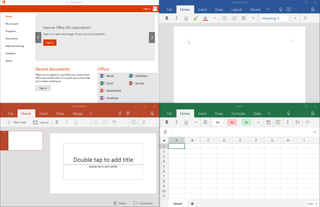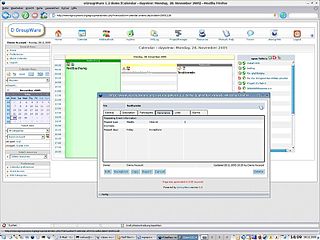
Microsoft Office, MS Office, or simply Office, is an office suite and family of client software, server software, and services developed by Microsoft. The first version of the Office suite, announced by Bill Gates on August 1, 1988 at COMDEX, contained Microsoft Word, Microsoft Excel, and Microsoft PowerPoint — all three of which remain core products in Office — and over time Office applications have grown substantially closer with shared features such as a common spell checker, Object Linking and Embedding data integration and Visual Basic for Applications scripting language. Microsoft also positions Office as a development platform for line-of-business software under the Office Business Applications brand.

Microsoft Access is a database management system (DBMS) from Microsoft that combines the relational Access Database Engine (ACE) with a graphical user interface and software-development tools. It is a member of the Microsoft 365 suite of applications, included in the Professional and higher editions or sold separately.
FileMaker is a cross-platform relational database application developed by Claris International, a subsidiary of Apple Inc. It integrates a database engine with a graphical user interface (GUI) and security features, allowing users to visually modify a database. Versions for desktops, servers, iOS, and web-delivery have been released.
DataFlex is an object-oriented high-level programming language and a fourth generation visual tool for developing Windows, web and mobile software applications on one framework-based platform. It was introduced and developed by Data Access Corporation beginning in 1982.
A GIS software program is a computer program to support the use of a geographic information system, providing the ability to create, store, manage, query, analyze, and visualize geographic data, that is, data representing phenomena for which location is important. The GIS software industry encompasses a broad range of commercial and open-source products that provide some or all of these capabilities within various information technology architectures.

ArcGIS is a family of client, server and online geographic information system (GIS) software developed and maintained by Esri.
A client access license (CAL) is a commercial software license that allows client computers to use server software services. Most commercial desktop apps are licensed so that payment is required for each installation, but some server products can be licensed so that payment is required for each device or user that accesses the service provided by the software. For example, an instance of Windows Server 2016 for which ten User CALs are purchased allows 10 distinct users to access the server.
SQL Server Reporting Services (SSRS) is a server-based report generating software system from Microsoft. It is part of a suite of Microsoft SQL Server services, including SSAS and SSIS.
Panorama Software is a Canadian software and consulting company specializing in business intelligence. The company was founded by Rony Ross in Israel in 1993; it relocated its headquarters to Toronto, Canada in 2003. Panorama sold its online analytical processing (OLAP) technology to Microsoft in 1996, which was built into Microsoft OLAP Services and later SQL Server Analysis Services, an integrated component of Microsoft SQL Server.
Microsoft SQL Server Compact is a discontinued relational database produced by Microsoft for applications that run on mobile devices and desktops. Prior to the introduction of the desktop platform, it was known as SQL Server for Windows CE and SQL Server Mobile Edition.

EGroupware is free open-source groupware software intended for businesses from small to enterprises. Its primary functions allow users to manage contacts, appointments, projects and to-do lists. The project releases its software under the terms of GNU General Public License (GPL).
Microsoft SQL Server is a proprietary relational database management system developed by Microsoft. As a database server, it is a software product with the primary function of storing and retrieving data as requested by other software applications—which may run either on the same computer or on another computer across a network. Microsoft markets at least a dozen different editions of Microsoft SQL Server, aimed at different audiences and for workloads ranging from small single-machine applications to large Internet-facing applications with many concurrent users.

Microsoft Azure SQL Database is a managed cloud database (PaaS) cloud-based Microsoft SQL Servers, provided as part of Microsoft Azure services. The service handles database management functions for cloud based Microsoft SQL Servers including upgrading, patching, backups, and monitoring without user involvement.

Windows Search is a content index and desktop search platform by Microsoft introduced in Windows Vista as a replacement for the previous Indexing Service of Windows 2000, Windows XP, and Windows Server 2003, designed to facilitate local and remote queries for files and non-file items in the Windows Shell and in compatible applications. It was developed after the postponement of WinFS and introduced to Windows several benefits of that platform.
Power Pivot, formerly known as PowerPivot, is a self-service business intelligence feature of Microsoft Excel which facilitates the creation of a tabular model to import, relate, and analyze data from a variety of sources.
Data Analysis Expressions (DAX) is the native formula and query language for Microsoft PowerPivot, Power BI Desktop and SQL Server Analysis Services (SSAS) Tabular models. DAX includes some of the functions that are used in Excel formulas with additional functions that are designed to work with relational data and perform dynamic aggregation. It is, in part, an evolution of the Multidimensional Expression (MDX) language developed by Microsoft for Analysis Services multidimensional models combined with Excel formula functions. It is designed to be simple and easy to learn, while exposing the power and flexibility of PowerPivot and SSAS tabular models.
Google Cloud Platform (GCP) is a suite of cloud computing services offered by Google that provides a series of modular cloud services including computing, data storage, data analytics, and machine learning, alongside a set of management tools. It runs on the same infrastructure that Google uses internally for its end-user products, such as Google Search, Gmail, and Google Docs, according to Verma et al. Registration requires a credit card or bank account details.
Realm is an open source object database management system, initially for mobile operating systems (Android/iOS) but also available for platforms such as Xamarin, React Native, and others, including desktop applications (Windows). It is licensed under the Apache License.

Microsoft 365 is a product family of productivity software, collaboration and cloud-based services owned by Microsoft. It encompasses online services such as Outlook.com, OneDrive, Microsoft Teams, programs formerly marketed under the name Microsoft Office, and enterprise products and services associated with these products such as Exchange Server, SharePoint, and Viva Engage. Microsoft 365 also covers subscription plans encompassing these products, including those that include subscription-based licenses to desktop and mobile software, and hosted email and intranet services.

Power Query is an ETL tool created by Microsoft for data extraction, loading and transformation, and is used to retrieve data from sources, process it, and load them into one or more target systems. Power Query is available in several variations within the Microsoft Power Platform, and is used for business intelligence on fully or partially self-service platforms. It is found in software such as Excel, Power BI, Analysis Services, Dataverse, Power Apps, Azure Data Factory, SSIS, Dynamics 365, and in cloud services such as Microsoft Dataflows, including Power BI Dataflow used with the online Power BI Service or the somewhat more generic version of Microsoft Dataflow used with Power Automate.









